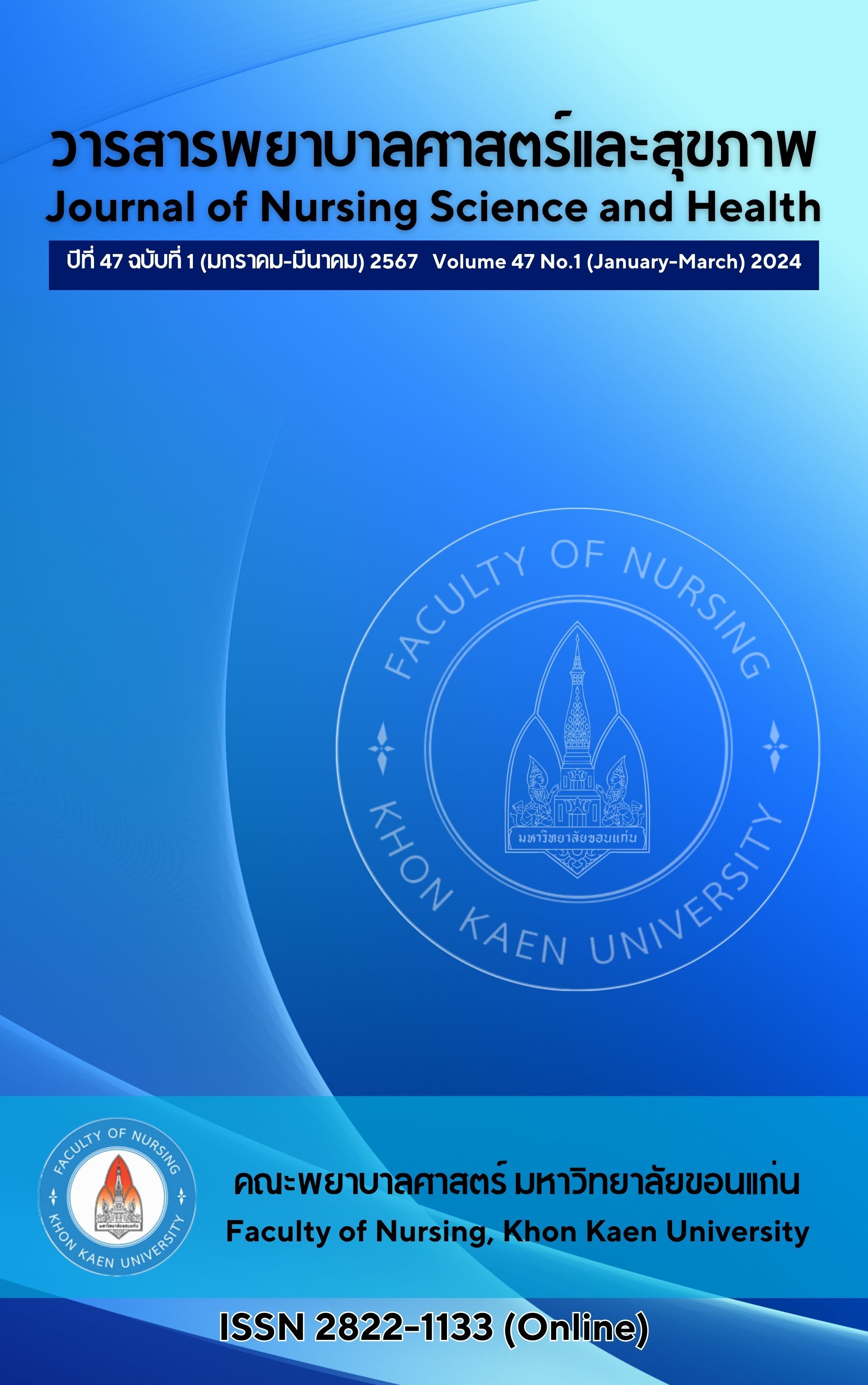การพัฒนาแบบประเมินพฤติกรรมการดูแลของผู้ดูแลผู้ป่วยเด็กและวัยรุ่นโรคลมชัก
คำสำคัญ:
เด็กและวัยรุ่น , พฤติกรรมการดูแล , ผู้ดูแล, โรคลมชักบทคัดย่อ
เครื่องมือที่ใช้ในการวิจัยเป็นสิ่งที่มีความสำคัญและมีบทบาทอย่างมากในการวิจัย เพื่อให้สามารถวัดได้ตรงกับสถานการณ์และลักษณะพฤติกรรมที่ต้องการจะวัด การวิจัยนี้มีวัตถุประสงค์เพื่อพัฒนาเครื่องมือวัดพฤติกรรมการดูแลของผู้ดูแลผู้ป่วยเด็กและวัยรุ่นโรคลมชัก และการตรวจสอบคุณภาพของเครื่องมือที่พัฒนาขึ้นเพื่อประโยชน์สูงสุดของการวัดให้สอดคล้องกับวัตถุประสงค์
กลุ่มตัวอย่าง คือ ผู้เชี่ยวชาญในการตรวจสอบเครื่องมือวิจัย จำนวน 3 คน และผู้ดูแลผู้ป่วยเด็กและวัยรุ่นโรคลมชัก จำนวน 40 คน เลือกกลุ่มตัวอย่างแบบเจาะจง เครื่องมือที่ใช้ในการวิจัย ได้แก่ แบบสอบถามพฤติกรรมการดูแลของผู้ดูแลเด็กและวัยรุ่นโรคลมชัก จำนวน 4 ชุด สำหรับผู้ดูแลเด็กโรคลมชักวัยหัดเดิน วัยก่อนเรียน วัยเรียน และวัยรุ่น ซึ่งพัฒนาขึ้นตามแนวคิดทฤษฎีการดูแลตนเองของโอเร็ม การวิจัยประกอบด้วย 3 ขั้นตอน คือ 1) สร้างเครื่องมือวิจัยจากแนวคิดหรือทฤษฎีที่เกี่ยวข้อง โดยการนิยามแนวคิดและนิยามเชิงปฏิบัติการของตัวแปร การร่างข้อคำถามในการวัดตัวแปร และการกำหนดรูปแบบของการวัด 2) ตรวจสอบคุณภาพของเครื่องมือวิจัยด้วยวิธีการหาดัชนีความสอดคล้องของข้อคำถาม (IOC) กำหนดเกณฑ์ที่ยอมรับได้ 0.60 ขึ้นไป ค่าดัชนีความเที่ยงตรงเชิงเนื้อหาทั้งฉบับ (S-CVI) 0.80 ขึ้นไป และทดลองใช้เครื่องมือวิจัยเบื้องต้น และ 3) ตรวจสอบคุณภาพของเครื่องมือวิจัยโดยใช้สถิติด้วยวิธีการตรวจสอบความเที่ยง โดยนำไปทดลองใช้กับกลุ่มผู้ดูแลผู้ป่วยเด็กและวัยรุ่นโรคลมชักที่มีคุณสมบัติเช่นเดียวกับกลุ่มตัวอย่าง และหาค่าความเชื่อมั่น (reliability) โดยกำหนดค่าสัมประสิทธิ์แอลฟาของครอนบาค (-coefficient) ที่ 0.70 ขึ้นไป
ผลการศึกษาพบว่า เครื่องมือประเมินพฤติกรรมการดูแลของผู้ดูแลผู้ป่วยเด็กและวัยรุ่นโรคลมชักที่สร้างขึ้นมีค่า IOC แต่ละฉบับ 0.67-1.00 ค่า S-CVI 0.81-0.93 และค่าสัมประสิทธิ์แอลฟาของครอนบาค 0.81-0.92 ถือได้ว่าเครื่องมือมีความน่าเชื่อถือ สามารถนำไปใช้ประเมินพฤติกรรมการดูแลของผู้ดูแลผู้ป่วยเด็กและวัยรุ่นโรคลมชักได้
เอกสารอ้างอิง
Neurological Institute of Thailand. Clinical practice guidelines for epilepsy. Bangkok: Tana Place; 2016. (in Thai)
Meadows-Oliver M. Pediatric nursing made incredibly. 3nd ed. Philadelphia: Wolters Kluwer Health; 2019.
Richardson B. Pediatric primary care: Practice guideline for nurses. Indiana: HealthNet; 2017.
Aaberg kM, Gunnes N, Bakken IJ, Soraas CL, Berntsen A, Magnus P, et al. Incidence and prevalence of childhood epilepsy: A national cohort study. Pediatrics 2017;139(5):e20163908.
Nikrothanond T, Limwattananon C, Limwattananon S. Medicine possession ratio of antiepileptics in pediatric patients with epilepsy in Queen Sirikit National Institute of child health. Journal of the Department of Medical Service 2020;45(3):98-106. (in Thai)
Sueram K, Chanrat P. Problems, needs and strengthening of caregivers of children with epilepsy by applying System Theory. Journal of Nursing Science & Health 2021;44(3):98-109. (in Thai)
Sakulrungjalas T. Effects of epilepsy on children: Prevention and treatment. Thai Journal of Nursing Council 2018;33(4):5-18. (in Thai)
Orem DE. Nursing: Concepts of practice. 6th ed. St. Louis, Mosby; 2001.
Srisaeng P. Theories and concepts related to nursing. Khon Kaen: Khon Kaen University Printing House; 2017. (in Thai)
Piasupan R, Thanattheerakul C. The effects of educative supportive program using VCD and handbook on caregivers’ caring behaviors for school age epilepsy. Journal of Nursing Science & Health 2017;40(2):11-21. (in Thai)
Saeui W. The effectiveness of educational program using cartoon animation video for caregivers of children with epilepsy on epilepsy knowledge of caregivers among children with epilepsy. Journal of The Department of Medical Service 2022;47(2):53-60. (in Thai)
Jarintana P, Kongsaktrakul C, Visudtibhan A. The effects of ability promoting program for caregivers of school-age children with epilepsy using CAI on knowledge, perceived self-efficacy, and outcome expectancy. The Journal of Faculty of Nursing Burapha University 2019;27(1):13-22. (in Thai)
Meehanpong P, Boonsin S. The development of nursing research instruments. Journal of The Royal Thai Army Nurses 2021;22(1):10-19. (in Thai)
Polit D, Beck CT. Essentials of nursing research: Appraising evidence for nursing practice. Philadelphia: Lippincott; 2014.
Pattanasombutsook M. Validation of nursing research reports and proper use of social science research instruments in publishing. The Southern College Network Journal of Nursing and Public Health 2021;8(2):329-43. (in Thai)
DeVellis RF. Scale development: Theory and applications. 4th ed. Thousand Oaks, CA: SAGE; 2017.
Gray JR, Grove SK, Sutherland S. Burns & grove’s the practice of nursing research: Appraisal, synthesis, and generation of evidence. 8th ed. St. Louis: Elsevier; 2017.
Phonphotthanamat W. A comparative study of verifying the content validity of a research instrument with the IOC, CVR and CVI. RSU Library Journal 2022;28(1):169-92.
Srisathitnarakoon B. Development and validation of research instruments: Psychometric properties. Bangkok: Printing House of Chulalongkorn University; 2012. (in Thai)
Chuayounan S. Mixed methods exploratory sequential design: Concept and application. Veridian E-Journal, Silpakorn University 2017;10(1):1394-404. (in Thai)
Bloom BA. Evaluation of learning in school. New York: McGraw-Hill; 1968.
Schinka JA, Velicer WF, Weiner IB. Handbook of psychology: Research methods in psychology, Vol. 2. Toronto: John Wiley & Sons Inc; 2013.
Chaichanawirote U, Vantum C. Evaluation of content validity for research instrument. Journal of Nursing and Health Sciences 2017;11(2):105-11. (in Thai)
Duangthipsirikul S. Finding or developing data collection tools to answer metrics [Internet]. Banngkok: Health Intervention and Technology Assessment Program; 2018 [cited 2022 Aug 16]. Available from: http://oec.anamai.moph.go.th/download/OEC_2016/MEET¬TING2561/MAR2561/18_21Mar2018/Lecture%20Instrument.pdf
Waltz CF, Strickland O, Lenz ER. Measurement in nursing and health research. New York: Springer Publishing Company; 2010.
ดาวน์โหลด
เผยแพร่แล้ว
รูปแบบการอ้างอิง
ฉบับ
ประเภทบทความ
สัญญาอนุญาต
ลิขสิทธิ์ (c) 2024 วารสารพยาบาลศาสตร์และสุขภาพ

อนุญาตภายใต้เงื่อนไข Creative Commons Attribution-NonCommercial-NoDerivatives 4.0 International License.
วารสารพยาบาลศาสตร์และสุขภาพเป็นเจ้าของลิขสิทธิ์ในการเผยแพร่ผลงานที่ตีพิมพ์ห้ามผู้ใดนำบทความที่ได้รับการตีพิมพ์ในวารสารพยาบาลศาสตร์และสุขภาพไปเผยแพร่ในลักษณะต่าง ๆ ดังนี้ การนำบทความไปเผยแพร่ออนไลน์ การถ่ายเอกสารบทความเพื่อกิจกรรมที่ไม่ใช่การเรียนการสอน การส่งบทความไปตีพิมพ์เผยแพร่ที่อื่น ยกเว้นเสียแต่ได้รับอนุญาตจากวารสารพยาบาลศาสตร์และสุขภาพ



